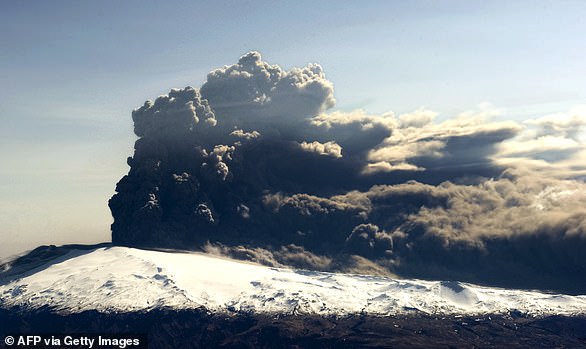Thousands of new earthquakes are recorded as experts reveals likely site of eruption and evacuated locals fear they will never be allowed to return
A volcanic eruption in Iceland in 2010 caused the worst disruption to air traffic since World War II.
Chaos ensued within the European travel industry when an unfortunate series of phenomena converged from a series of relatively minor volcanic events at Eyjafjallajokull, on the south side of the island.
The seismic activity began in late 2009 and intensified until March 20, when the volcano – which is covered by an ice sheet – finally erupted.
The eruption was small: just one in seven on the scale used to measure eruptions. Globally, it seemed like a relatively minor event at the time.
But about five days later, scientists began noticing unusual activity.
They found evidence that magma flowed from beneath the crust into Eyjafjallajokull’s magma chamber and that the pressure resulting from the process caused a massive displacement of the Earth’s crust.
While the eruption started as an exuberant eruption – with lava from the volcano flowing over the ground – the volcano entered an explosive stage on April 14. This time the explosion measured as a four on a volcanic scale.
Meanwhile, the ice around the volcano began to melt and began to flow into the volcano.
This rapid cooling caused the magma to disintegrate into fine and jagged ash particles. It also increased the explosive power of the volcano.
While the eruption started as an exuberant eruption – with lava from the volcano flowing over the ground – the volcano entered an explosive stage on April 14. This time the explosion measured as a four on a volcanic scale.
A huge cloud of ash was shot into the sky, reaching a height of nine kilometers. The explosion also ejected approximately 250 million cubic meters of volcanic material into the air.
To make matters worse, the volcano was directly under a jet stream, and the rapid cooling by the ice water gave the volcano enough force to shoot the ash directly into it.
The jet stream was also unusually stable at the time, continually sending ash particles from the volcano south-east – towards Europe.
From April 14 to 20, ash from the volcanic eruption covered large parts of Northern Europe.
About 20 countries closed their airspace to commercial jet traffic, affecting around 10 million travelers, with nearly 100,000 flights canceled to and from and within Europe over the six-day period.
The Airport Operators Association (AOA) estimated that airports lost £80 million in six and a half days, while the disruption lasted around a month.
In Great Britain alone, thirteen travel companies went bankrupt in the summer of 2010. The disruption of the ash cloud was cited as one of the factors.

A huge cloud of ash was shot into the sky, reaching a height of nine kilometers. The explosion also ejected approximately 250 million cubic meters of volcanic material into the air
Several sports matches were postponed, while Liverpool football club had to travel to Madrid by coach to play a match in the Europa League.
While most of the travel disruption occurred in April, volcanic activity at Eyjafjallajokull continued until October, when scientists declared the eruption over.
In 2011, a volcano beneath the Vatnajökull Glacier sent thousands of tons of ash into the air in just a few days, raising concerns about a repeat of the travel chaos seen across northern Europe.
Although the explosion was larger than that of Eyjafjallajokull, the impact was not as widespread.
A total of 900 flights (out of 90,000 in Europe) were canceled due to the eruption during the period May 23-25.
In 2014, Bárðarbunga erupted, which was the largest eruption in Iceland in more than 200 years. However, as a result, only local travel was affected.
